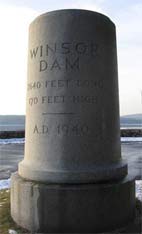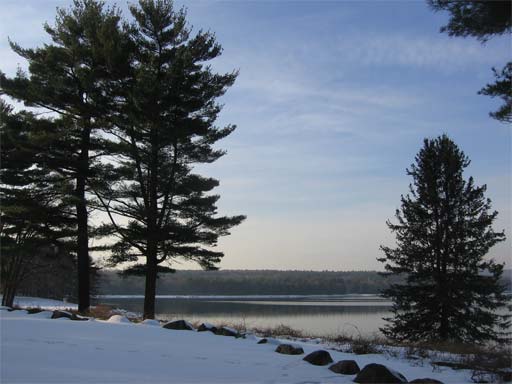and problematic species
The Quabbin Reservoir
Facts
The Quabbin Reservoir is the main source of water for much of Massachusetts, including both downtown and the suburbs of Boston, and many other communities throughout the state: about 40% of Massachusetts communities get their water from the Quabbin. The reservoir is the largest body of water in Massachusetts, covering 39 square miles, with a total of 118 miles of shoreline. When filled to capacity, it holds 412 billion gallons of water, and can yield 158 million gallons/day. This water is distributed by 117 miles of pipes, most of which are located in bedrock about 200 feet below ground. The reservoir's average depth is 45 feet, with a maximum depth of 151 feet.

The Quabbin Reservoir boasts a watershed that covers 119,940 acres, with about 150 miles of tributary draining into the reservoir. This watershed is managed by the Massachusetts Department of Conservation and Recreation. Less than 5% of the watershed land is developed. The Quabbin is the largest untreated drinking water supply in the United States - the large and undeveloped forests of the watershed act as a natural filter, purifying the water enough so that further filtration is not necessary. They also provide suitable and abundant habitat for many animal species, including bald eagles, moose, white-tailed deer, beavers, coyotes, loons, bobcats, and wild turkeys, among many others. The Quabbin is home to at least 27 species of "special concern" in Massachusetts.
The name "Quabbin" is a Nipmuc Indian word meaning "meeting of the waters." The Quabbin today is fed by three branches of the Swift River, and also receives water seasonally from the Ware River. The watershed forests are made up mostly of red and white oak, white and red pine, birch, and hemlock. Other than these hardwood and conifer forests, the Quabbin watershed includes wetlands, swamps, talus slopes, and bedrock outcrops. Selective logging (monitored by foresters) is practiced throughout the forests to maintain the desired diversity of forest types and age structure. Timber is harvested at approximately 8-10 million board feet/year, or about 40-67% of annual growth. Selective logging is used to maintain high levels of species and age diversity among the trees.
History
Due to its rapid growth in the nineteenth century, the Boston metropolitan area quickly began to run short on water. After many ideas were proposed, the Cochituate Aqueduct was built at Lake Cochituatew in Wayland and Natick, just west of Boston. In 1875, the city again began to run its water sources dry. Five new reservoirs were built on the Sudbury River in Framingham, still further west, as well as the Sudbury Aqueduct. However, even these additional supplies were not enough. In 1908, construction on the Wachusett Reservoir was completed. at the time, the 7-square-mile Wachusett was the largest body of water in Massachusetts, and the largest public water reservoir in the world. The Wachusett, located in Clinton, is still active today. However, even this massive reservoir was still not enough to satisfy the demand for water coming from the still-growing eastern part of the state.

 In 1926, construction began on what would eventually become the Quabbin Reservoir, still further west. A tunnel was built connecting the Wachusett Reservoir with the Ware River. This tunnel was then connected to the Swift River, and became known as the Quabbin Aqueduct. To create the reservoir, a dam was built on the Swift River. This plan was vehemently opposed by local residents, who went to court in an attempt to halt the construction. The case went to the Massachusetts Supreme Court, but the residents lost, and the project moved forward. Construction of the dam began in 1936, and was completed in 1939. This dam became known as the Winsor Dam, named after the chief engineer of the project, Frank Winsor. Another smaller dam, the Goodenough Dike, was also built. Water from the river quickly flowed into the valley, but it still took seven years for the reservoir to fill. In the process, the rural towns of Dana, Prescott, Greenwich, and and Enfield were completely submerged. Their residents were forced, mostly against their will, to move to surrounding towns. Many of the monuments, cemeteries, and public buildings from these towns were moved as well; those that were not were demolished.
In 1926, construction began on what would eventually become the Quabbin Reservoir, still further west. A tunnel was built connecting the Wachusett Reservoir with the Ware River. This tunnel was then connected to the Swift River, and became known as the Quabbin Aqueduct. To create the reservoir, a dam was built on the Swift River. This plan was vehemently opposed by local residents, who went to court in an attempt to halt the construction. The case went to the Massachusetts Supreme Court, but the residents lost, and the project moved forward. Construction of the dam began in 1936, and was completed in 1939. This dam became known as the Winsor Dam, named after the chief engineer of the project, Frank Winsor. Another smaller dam, the Goodenough Dike, was also built. Water from the river quickly flowed into the valley, but it still took seven years for the reservoir to fill. In the process, the rural towns of Dana, Prescott, Greenwich, and and Enfield were completely submerged. Their residents were forced, mostly against their will, to move to surrounding towns. Many of the monuments, cemeteries, and public buildings from these towns were moved as well; those that were not were demolished.
In addition to providing water for much of eastern Massachusetts, a few towns in western Massachusetts get their water from the Quabbin as well. In 1947, the Chicopee Valley Aqueduct was built, which allowed the towns of Chicopee, Wilbraham, and South Hadley to access water from the Quabbin. Currently, the reservoir provides water for approximately 2.5 million people in 46 communities, and has adequately fulfilled the water needs of the state. As stated above, is still one of the most pristine sources of drinking water on the planet.

| © 2008 Jason, Jeff, Julian & Juliet | ↑ go to the top | Design by Nicolas Fafchamps |